
World
15:58, 24-Dec-2018
2018 Reporters' look back: Asia's year of disasters
Updated
21:29, 27-Dec-2018
By Barnaby Lo
00:22
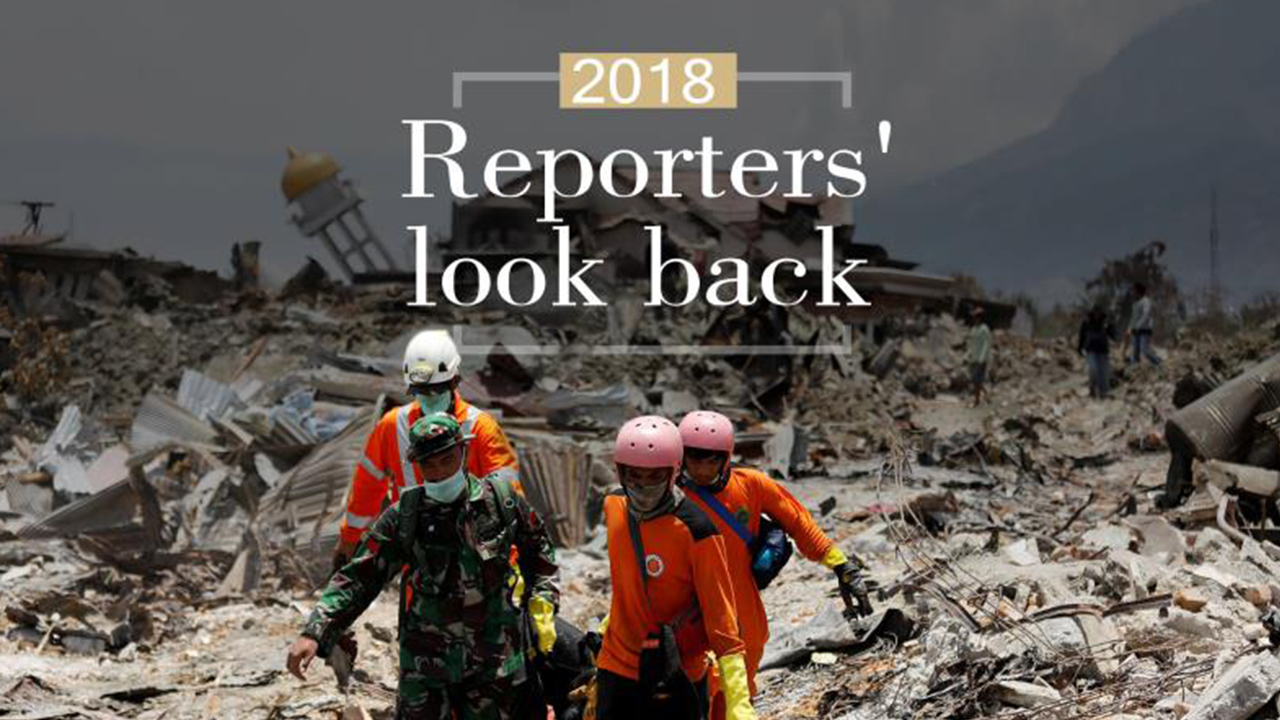
"To waste this opportunity in Katowice would compromise our last best chance to stop runaway climate change. It would not only be immoral, but it would also be suicidal," said Antonio Guterres, UN secretary-general, at this year's climate change conference in Poland.
I have covered countless natural disasters throughout the years. From what I have seen, there is no denying; storms are getting bigger and stronger, rainfalls are intense and more frequent, and the temperatures are rising.
The year 2018 was a testament to this reality.
The monsoon season started out relatively kindly to the Philippines, which is where I live and where an average of 20 typhoons barrel their way each year. I started my months-long reporting of disasters instead in Japan.
Over the course of one weekend in July, more than a month's average amount of rainfall was recorded in the country's western region. The rain set off landslides and caused record flooding.
When my team and I arrived in the small town of Kurashiki, most of the flooding had already subsided. But there were furniture, appliances, toys, photo frames and all sorts of broken pieces of memories from empty houses piled and lined up on the streets that were pitch-dark.
In Hiroshima, we met Masumi Fujita, sitting outside an evacuation center and staring blankly. His face exuded shock and his eyes narrated a painful story.
"I could have done something to save her. I could have asked her to evacuate," said Fujita.
His girlfriend was home when a landslide leveled their neighborhood. She was still missing when we met Fujita.
The monsoon-triggered floods and landslides killed more than 200 people. But that was not the end of Japan's misery. A punishing heatwave followed, and in September, the same region devastated by July's incessant rain was battered by a powerful typhoon. A few days later, an earthquake struck the country's northern region of Hokkaido, and I was back in Japan.
I witnessed one tragedy after another in Japan, but in my eyes, there was a silver lining. While the intensity of the monsoon and the earthquake were both unpredictable, the government's response was quick and efficient.
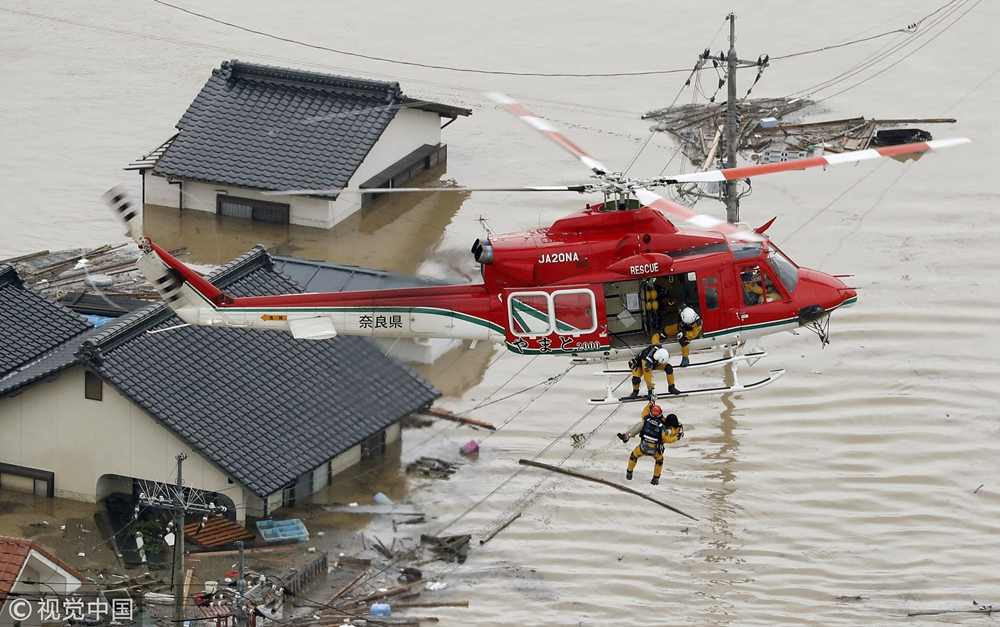
Rescue workers on a helicopter rescue a local resident from a submerged house at a flooded area in Kurashiki, southern Japan, July 7, 2018. /VCG Photo
Rescue workers on a helicopter rescue a local resident from a submerged house at a flooded area in Kurashiki, southern Japan, July 7, 2018. /VCG Photo
I was impressed with what I saw when I first visited an evacuation camp in Japan back in July. The school gymnasium in Kurashiki, which served as an evacuation center for flood victims, was air-conditioned. Survivors, who ought to be commended well for their calm and discipline, were provided with mattresses, blankets, and food. Search and rescue workers also worked night and day to find survivors and retrieve bodies. They were done even before we were done covering the story.
This is the kind of response developing countries like the Philippines can only hope for. That's not to say, however, that Filipinos have not learned lessons from their seemingly endless battle with natural calamities.
As the threat of typhoon Mangkhut, then forecast to be the year's most dangerous storm, loomed over the northern Philippines, local governments on the eastern seaboard evacuated residents. Straight from Hokkaido, my cameraman and I traveled to Cagayan province, where Mangkhut was expected to make landfall.
The typhoon roared into the region just as forecasters had predicted, but in areas where its winds unleashed their full strength, the death toll turned out to be relatively low; preparations had paid off.
Further west, however, in the mountainous regions of the northern Philippines, heavy rainfall triggered landslides. In one community alone, dozens of miners were buried alive.
Week after week, I saw death and destruction. I thought typhoon Mangkhut was the end of it. It had to be.
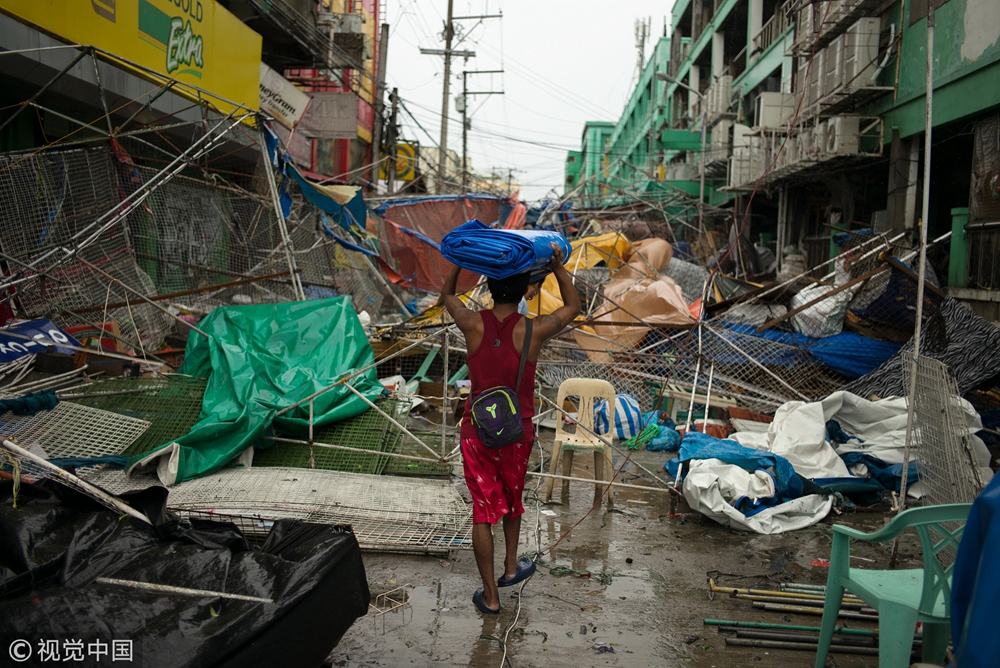
A man walks through the wreckage and debris of street stalls after typhoon Mangkhut in Cagayan, the Philippines, September 15, 2018. /VCG Photo
A man walks through the wreckage and debris of street stalls after typhoon Mangkhut in Cagayan, the Philippines, September 15, 2018. /VCG Photo
But the Friday night just as September was about to end, and as I was mindlessly grocery-shopping, an email came. I saw the words "earthquake" and "tsunami." I checked Twitter. True enough, a 7.5-magnitude earthquake had jolted Indonesia's Central Sulawesi province. Video of a tsunami also started circulating online.
I knew it was going to be one of the year's biggest stories, but nothing could have prepared me for what we had to go through and what we witnessed.
The epicenter of the earthquake and subsequent tsunami was the city of Palu, which like Tacloban in the central Philippines, was built along a coastline. In November 2013, super typhoon Haiyan tore Tacloban apart and took thousands of lives, I was there during the thick of the storm and almost died.
Getting into Palu was like seeing Tacloban in the immediate aftermath of Haiyan all over again. Everywhere homes and buildings had been reduced to rubble. I was inside a vehicle and yet I could almost smell death.
01:25
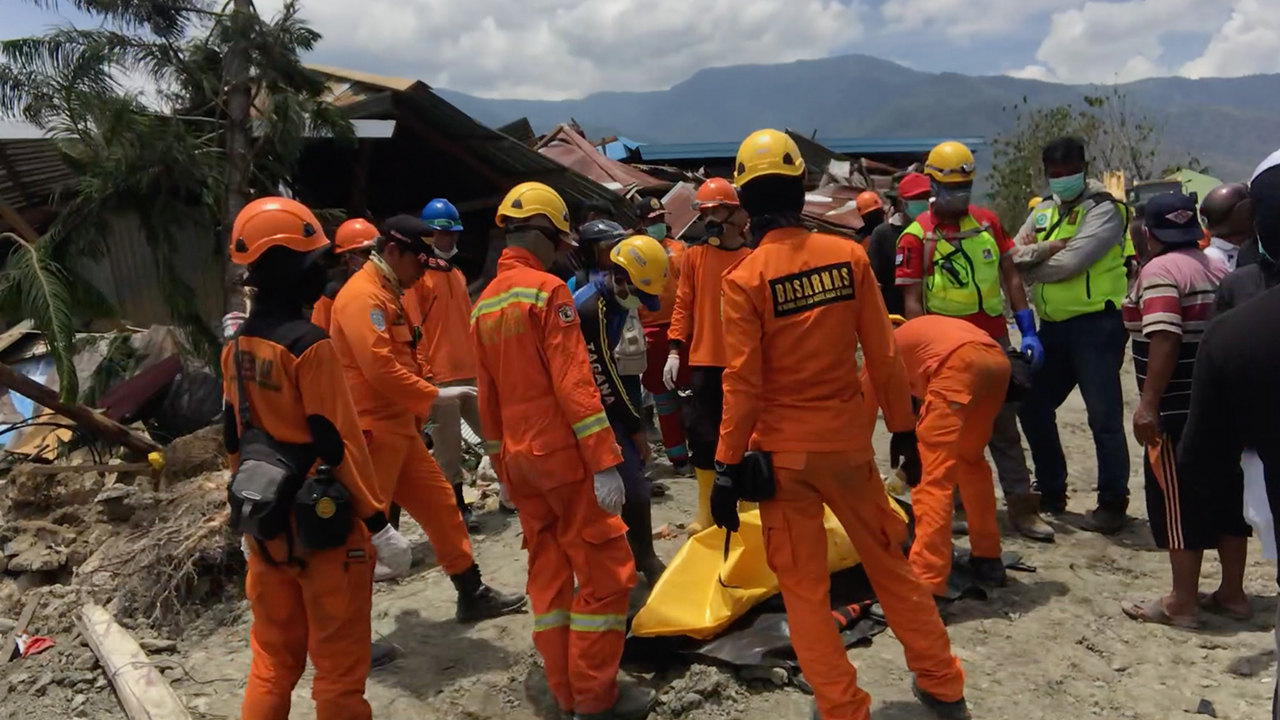
There was panic and confusion all around due to fears that another major earthquake would strike soon. With power and communication lines down, food and water in short supply, and their homes either gone or damaged, residents were scrambling to get out of Palu.
Vehicles getting into gas stations stretched several kilometers long, while the airport, then just partially operational, was brimming with survivors hoping to get on a flight – any flight – out of the chaotic city.
Those who couldn't afford to leave stayed, but they were in makeshift shelters with conditions that were far from what I saw in Japan. A woman named Ustiana started rolling on the ground when she recounted to me how she and her family survived the tsunami. It was stunning to see how real the trauma was.
Anger was also boiling over what survivors said was their government's slow and inadequate response – from the apparent absence of a tsunami warning to the scarcity of relief aid. Most of the evacuees we spoke with told us that aid was only trickling in.
It was, understandably, not easy delivering aid to isolated places, but there was a sense that bureaucracy was stalling much-needed foreign aid. Politics was also getting in the way, some survivors complained.
I am no expert in Indonesian affairs but I have seen aftermaths of many natural disasters and nowhere else have I seen makeshift tents for survivors as many as in Palu. Most of them were made of scrap canvas and had very little ventilation. I hardly saw aid workers, so when evacuees say they had been left mostly to fend for themselves, there was no reason to doubt them.
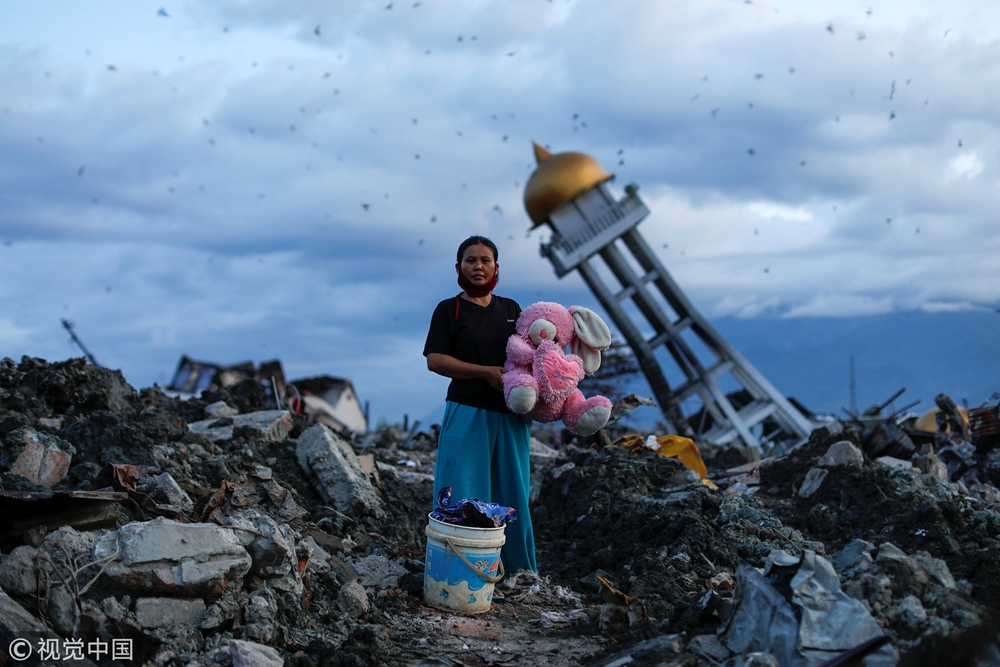
A woman holds a toy found at her destroyed house where she had lost her three children after the area was hit by an earthquake, Sulawesi, Indonesia, October 7, 2018. /VCG Photo
A woman holds a toy found at her destroyed house where she had lost her three children after the area was hit by an earthquake, Sulawesi, Indonesia, October 7, 2018. /VCG Photo
Even in communities where scores remained missing, residents were searching for relatives on their own. We met an entire brood looking for their parents in the Balaroa government housing complex, where loosened soil carried homes like waves would in a phenomenon called soil liquefaction.
"We just want to be able to bury them," one of the siblings said.
When I was about to leave Indonesia after a 10-day stint, however, word was that the search for the missing was going to be halted, and entire communities like Balaroa could become mass graveyards.
Martinus Hamaele couldn't conceal his disappointment at the pace at which search and rescue efforts moved. His daughter, an employee of Mercure Hotel, was inside when it collapsed. If they ever were in a race against time, he said it did not feel that way.
"I felt strongly that my daughter was still alive the first three days after the earthquake and tsunami. But search and rescue were going slowly; I think that's why she didn't make it," a grieving Hamaele told me during the funeral of his daughter Meyren.
Meyren Hamaele was 20 years old, with a future of promising possibilities ahead of her.
Together with his son, Hamaele dug through the rubble of the hotel. He didn't find his daughter, but he helped save other lives.
"My son and I helped four people crawl out of a tiny space under the rubble," said Hamaele.
It is no consolation for losing a loved one but Hamaele said it gives him comfort knowing other families won't have to experience his grief.
Amidst the darkness and frustration, surrounded only by ruins and dilapidation, Hamaele was a ray of sunshine. But it wasn't just him; in fact, I also had the good fortune of meeting a good Samaritan on our way to Palu from Jakarta, a journey which took more than two days of air and land travel.
Her name was Amalia. She did not speak a word of English but there was warmth and generosity in her voice. She welcomed us to her home with open arms on a night when we could not find a place to stay. We would have traveled through the dark with our safety on the line if not for her and her family.
Later, I found out she had relatives in Palu who were still missing. And yet, she was thoughtful and gracious, with a smile and occasional laughter that exuded resilience.
It's the kind of resilience that has helped the Japanese, Filipinos, and Indonesians get through tragedies. But resilience is not going to be enough anymore if future generations are going to confront more catastrophes. Only with better preparation and more timely response can the battle against mother nature's wrath be won.
(Top image: Rescue workers and a soldier remove an earthquake victim in the Balaroa neighborhood in Palu, Central Sulawesi, Indonesia, October 6, 2018. /VCG Photo. Graphic by Sa Ren.)

SITEMAP
Copyright © 2018 CGTN. Beijing ICP prepared NO.16065310-3
Copyright © 2018 CGTN. Beijing ICP prepared NO.16065310-3